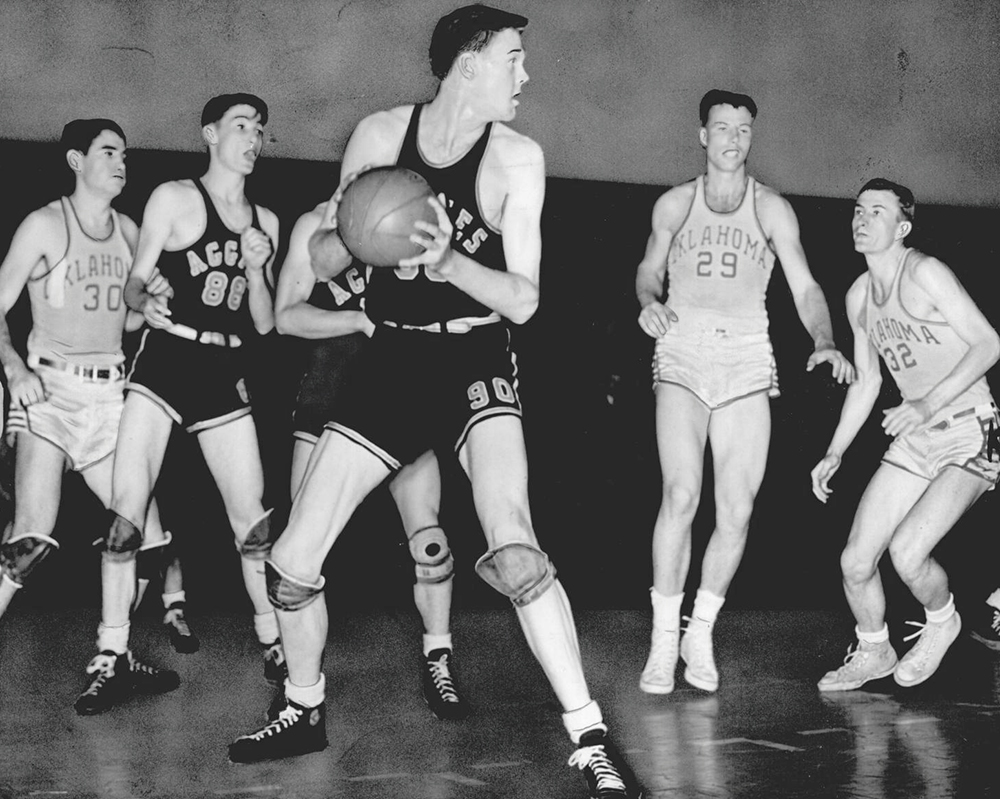The Encyclopedia of Oklahoma History and Culture
KURLAND, ROBERT ALBERT (1924–2013).
Bob Kurland, the first seven-foot-tall player in college basketball history, led Oklahoma A&M College (now Oklahoma State University) to the heights of back-to-back NCAA championships in 1945–46, but it was far from easy for Kurland or Coach Hank Iba. Kurland scored 1,669 points during his four-year career under Iba, leading the nation as a senior in 1946 with 643 points in thirty-three games for a 19.5 average. His fifty-eight points against St. Louis in 1946 remained a school record until 1979. It was on defense, however, that Kurland earned his place at Oklahoma A&M and where he continued to excel.
Born in St. Louis, Missouri, on December 23, 1924, where he played high school basketball, Kurland met Iba in 1942. Too tall to serve in the armed forces during World War II, Kurland was still a gangling boy when he came to Stillwater as a freshman. Iba was not convinced a player of Kurland's size (actually six feet, ten inches) could develop the skills and stamina to play basketball. Most of the best "tall" players were six feet, two inches to six feet, five inches at that time.
Kurland suffered humiliation in the press that first year when Oklahoma A&M played in New York City. Kansas Coach Phog Allen called Kurland "a glandular goon." In the final game of that year Iba stationed Kurland under the goal, and the Aggies defeated the University of Oklahoma 40 to 28. Under the rules at that time Kurland could bat away balls not inside the basket. During the summer of 1943 Floyd Burdette, who was stationed in Stillwater with the U.S. Army Air Corps, aided Kurland. Burdette taught Kurland how to use his height and general size in controlling play under the basket. Kurland became the hub of the offense and defense. At Norman, University of Oklahoma Coach Bruce Drake had a player take warm-up shots on stilts to embarrass Kurland, and a rules committee chairman was perched above the basket to make sure Kurland did not reach inside the hoop. A&M won, 14 to 11.
Kurland continued working for his scholarship, often sweeping the Gallagher Hall floor before a game, and he became an All-American. He led the Aggies to the final of the National Invitational Tournament in 1944 and then to the National Collegiate Athletic Association championships in 1945–46. After winning the NCAA title in 1945, Oklahoma A&M played NIT champion DePaul in a Red Cross benefit game. Kurland outplayed six-foot-nine George Mikan in a 52 to 44 victory that meant an undisputed national championship. Kurland was named All-American three years in a row and won the 1946 Helms Foundation award as the nation's outstanding player. After he graduated, Kurland went on to further basketball heights, playing for the Phillips Petroleum Company 66ers and with gold-medal–winning U.S. Olympic teams in 1948 and 1952. After basketball, he had a long career of employment with Phillips. Bob Kurland died on September 29, 2013, in Florida.
See Also
ALVAN LEIGH ADAMS, BASKETBALL, DONALD LEE HASKINS, MARQUES HAYNES, WILLIAM MARK PRICE, RECREATION AND ENTERTAINMENT, SPORTS, WAYMAN TISDALE
Bibliography
John Paul Bischoff, Mr. Iba: Basketball's Iron Duke (Oklahoma City: Oklahoma Heritage Association and Trackmaker Series Inc., 1980).
"Bob Kurland," Vertical Files, Archives, Oklahoma Sports Hall of Fame, Oklahoma City.
Citation
The following (as per The Chicago Manual of Style, 17th edition) is the preferred citation for articles:
Max Nichols, “Kurland, Robert Albert,” The Encyclopedia of Oklahoma History and Culture, https://www.okhistory.org/publications/enc/entry?entry=KU003.
Published January 15, 2010
© Oklahoma Historical Society


